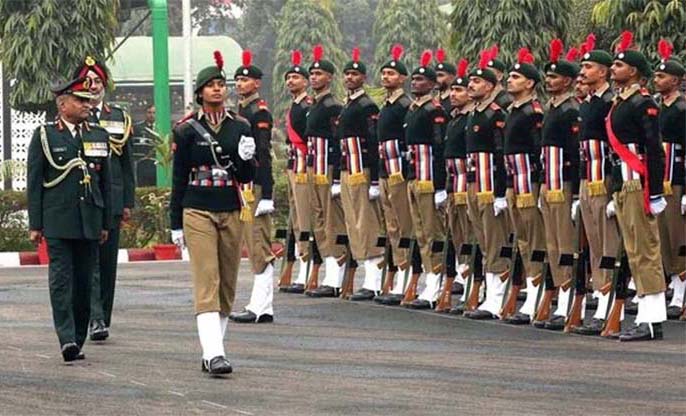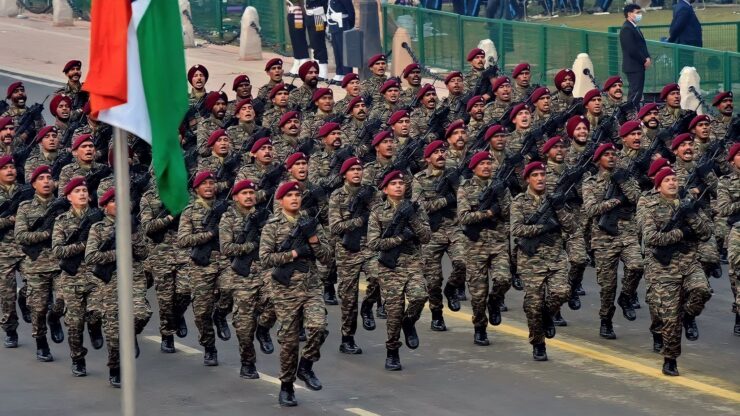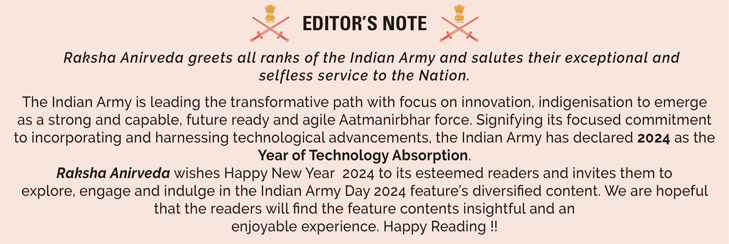
The theme for Indian Army Day 2024 is “In Service of the Nation.” This theme encapsulates the core essence of the Indian Army’s existence – to serve the nation with unwavering commitment, dedication, and professionalism. It highlights the selfless sacrifices made by the Indian Army personnel to safeguard the nation’s security and uphold its values, over the years.
The theme resonates with the Indian Army’s motto, “Service Before Self”, emphasising the primacy of national service over individual interests. It underscores the Indian Army’s unwavering commitment to protecting the nation’s sovereignty, territorial integrity, and the well being of its citizens.
Indian Army Day 2024 Celebrations
This year the centrepiece of the celebrations will be a grand parade at the Parade Ground in Lucknow, U.P., showcasing the Indian Army’s strength, discipline, and operational readiness.
The crowd will be able to witness the synchronised march past of various regiments, each with its unique history and traditions, symbolising the unity and diversity of the Indian Army.
This year the centrepiece of the Army Day celebrations will be a grand parade at the Parade Ground in Lucknow, U.P., showcasing the Indian Army’s strength, discipline, and operational readiness
They’ll also be able to gaze at the sky in awe as fighter jets and helicopters perform breath-taking aerial manoeuvres, demonstrating the Indian Army’s airpower and technological prowess. In addition, on the occasion IA will also honour the sacrifices of its veterans who have served the nation with bravery and distinction. This will be in addition to a vibrant cultural extravaganza, featuring traditional dances, music, and displays of military heritage.
The Lucknow city holds a special place in Indian military history, having witnessed several battles and uprisings. Hosting the Army Day in Lucknow pays tribute to the city’s rich military heritage and the valour of its people. In addition, Lucknow’s central location in northern India makes it an ideal venue to reach a wider audience and showcase the Indian Army’s presence across the nation. Besides capturing the city’s vibrant cultural tapestry.
Origins of the Indian Army Day
The roots of Indian Army Day can be traced back to the pre-independence era. In 1941, the first Indian contingent of the Indian Army, then known as the Royal Indian Army, was commissioned. This marked a significant step towards the Indianisation of the armed forces, paving the way for India’s eventual self-reliance in defence.
On January 15, 1949, General (later Field Marshal) KM Cariappa took over as the first Indian Commander-in-Chief of the Indian Army, replacing General Sir Francis Roy Bucher. This historic event symbolised the Indian Army’s transition from British command to the Indian leadership, marking a new era of self-governance and national pride.
Over the years, India’s military strategy has revolved around a posture of “inhibitive deterrence” against Pakistan and a policy of “inhibitive defence” against China

Indian Army Over the Years
The occasion also provides us an opportunity to analyse how the Indian Army has evolved and changed its preparedness and priorities in view of the emerging challenges from across the border on both its eastern and western sectors.
Over the years, India’s military strategy has revolved around a posture of “inhibitive deterrence” against Pakistan and a policy of “inhibitive defence” against China. A strong dissuasive deterrence capability against Pakistan implies maintaining a pro-active posture with a significantly favourable force ratio in the region of 2:1.
However, since the early Nineties, due to dwindling defence budgets and over-burgeoning voids of equipment, armaments, ammunition and stores, this favourable force ratio started declining. The problem was compounded by delays in up-gradation and modernisation plans of all the three services. The combat effectiveness ratios had, perhaps, declined to such an extent that Pakistan was no longer deterred to carry out the Kargil aggression and India was on the defensive.
In the current geo-political situation, it becomes imperative for the IA to revolutionise its affairs coupled with embracing technologies to improve the cutting edge of the armed forces
Lessons Learned?
Kargil revealed many chinks in our armour, and the Army should learn from them. IA’s history is replete with examples of it having failed to learn from its failures and debacles. Whether it was the Sino-Indian conflict of 1962 or the Indo-Pak War of 1965 or even the intelligence failure in Operation Pawan in Sri Lanka in 1987, IA ignored the lessons to be learnt from these episodes.
In the current geo-political situation, it becomes imperative for the IA to introduce a crucial mindset change in military affairs coupled with embracing technologies to improve the cutting edge of the armed forces. Whether it is the state-of-the-art battlefield surveillance systems, ground and air based sensors or long-range precision weapons, night-vision devices, air-mounted radars or satellite surveillance and communication systems – all these armaments and equipment would give a tremendous power boost to the IA.
Further, in this era of information and knowledge-based warfare, jointmanship between the three services also becomes an essential factor for securing success in war. The elements of jointmanship were seen in the joint army and air force effort in vacating the aggression in Kargil. However, IA has yet to evolve a joint-doctrine or a joint-structure for fighting wars and conflicts, which are turning increasingly complex.
MoD must carry out a long-term strategic review to evolve a ‘National Security Perspective’, leading to a radical ‘National Security Strategy’ reviewed periodically
Within the army itself greater attention needs to be paid to the modernisation of the infantry on priority basis. The border manning and internal security duties need to be handed over to the paramilitary forces, allowing the army to focus on its core duties.
Long-term Planning
The long-range precision strike power of the artillery needs to be enhanced to pose a strong deterrent to the enemy. If future wars are going to be limited in scope, duration and depth, with inhibitions on escalation, then India needs to have a re-look at the structuring of its deep battle assets in terms of armoured and mechanised formations, without, in any way, diminishing their combat capabilities.
PM Narendra Modi had absolute clarity on this issue when he addressed the Combined Commanders Conference on December 15, 2015, “Modernisation and expansion of forces at the same time is a difficult and unnecessary goal. We need forces that are agile, mobile and driven by technology, not just human valour. We need capabilities to win swift wars, for we will not have the luxury of long drawn battles.”
Eight years down the line, the transformation process PM Modi directed to be implemented, seems to be in disarray. Though, there has been much rhetoric from the political and military hierarchy about numerous standalone reforms in the offing.
However, despite the appointment of the Chief of Defence Staff on December 31, 2019, none of the major reforms, except a policy with respect to Aatmanirbharta or self-reliance in defence equipment, is yet to deliver.
Historically, transformation of the military is politically driven. The Ministry of Defence must carry out a long-term strategic review to evolve a ‘National Security Perspective’, leading to a radical ‘National Security Strategy’ reviewed periodically.
India’s enemies have far exceeded their preparedness and to counter them, we would need a fine balance of spending and preparedness, so as to be more tuned to the changing warfare mechanism
The above process will decide the size and capability of the armed forces. Currently, IA is engaged in incrementally reforming the armed forces tailored for wars and conflicts of a bygone era. What it needs is their transformation, from “top to bottom” in concept and “bottom to top” in execution. It must be steered by an empowered committee headed by the defence minister.
Additionally, looking at the contours of future warfare, Artificial Intelligence – AI, Former COAS, General M.M. Naravane, in an interview last year said that AI will have a dominant role in military operations. All future procurements and upgrades by IA will incorporate AI, wherever feasible.
He said that the military is also exploring military applications of 5G technology that have vital strategic and battlefield implications, as next generation of military communication infrastructure will be based on 5G.
Similarly, Quantum Technology will hold significant implications for the future of military communication and encryption, with next-gen quantum technologies developed at a phenomenal rate. Our aim should be to deliver indigenous technologies for our future solutions, Gen Naravane said.
The Army Day 2024 gives us a much-needed opportunity to introspect and plan and strategies for the future. To achieve this, we need to have a paradigm shift in deciding on how the IA operates and how the government supports the IA to keep pace with rapidly changing scenario of warfare globally.
It would not be wrong to say that our enemies have far exceeded their preparedness and to counter them, we would need a fine balance of government spending and for the IA, to be more tuned to the changing warfare mechanism, and design itself to operate in such a scenario. Only then we’ll be able to say that India’s progress in various fields is commensurate with its defence forces also.
–The writer is a political commentator based in New Delhi. He can be contacted on www.asadmirza.in. The views expressed are of the writer and do not necessarily reflect the views of Raksha Anirveda











